Cultural plurality has been present in the history of humanity ever since the dawn of time, and Brazil’s cultural background is one out of many examples of how you can learn a lot about a place just by studying its art history.
Having its origins traced back to prehistorical times, Brazilian art has gone through many phases throughout the course of the years, mixing the influences from the outside cultures that inhabit the country with a strong cultural identity.
In this post, we’re going to break down everything about Brazilian art, starting with a quick history lesson on Brazil’s major art movements, showing you some of the most important art pieces and artists from each of them, and taking a look at Brazilian contemporary art as well. Ready to feel inspired?
Brazilian Prehistorical Art
The first signs of Brazilian art can be found in hundreds of archeological sites spread across the national territory. These caves, which were used as shelters by our prehistorical ancestors, contained paintings made with minerals (like charcoal) and natural pigments extracted from both plant and animal sources (like blood and concentrated juices).
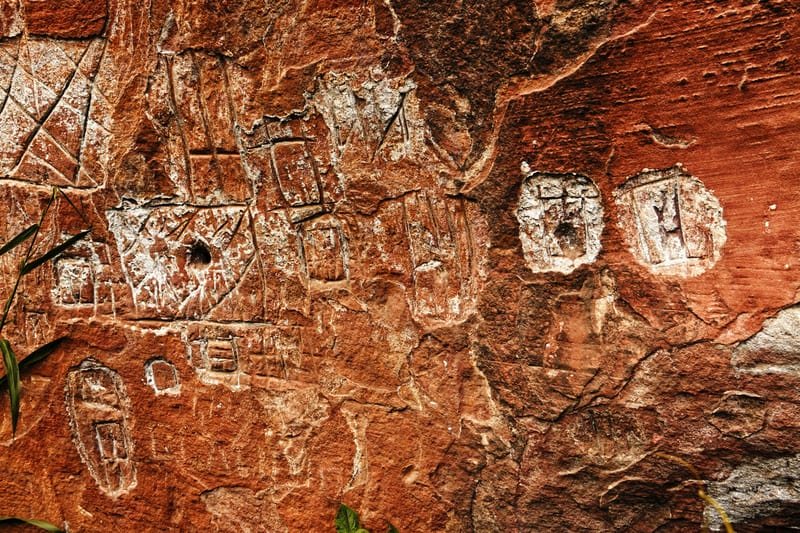
The oldest of these paintings was found in Piauí, and it’s believed to be over 15,000 years old. In Paraíba, another Brazilian state located in the north of the country, the way that the 11,000-year-old paintings found were done indicate that bones, clay, stones, and horns were being used to assist both in everyday situations and in ceremonial acts.
This shows a growing concern with general aesthetics and registering that people were trying to evolve not only their main tools of living but also their techniques in regards to the art they painted on the walls.
Brazilian Native Indigenous Art
When the land that would soon be known as Brazil was invaded and colonized by the Portuguese in 1500, there approximately five million native indigenous people living in the country. Unfortunately, a great portion of the first inhabitants of Brazil was killed during the Portuguese invasion, and much of their culture was either lost or diluted throughout the ages.
Brazilian Native Indigenous Art Before The Portuguese Invasion and Colonization
Originally, the native indigenous people made decorative and ceramic objects like vases and statuettes in the shape of humans (anthropomorphic) or animals (zoomorphic), as well as masks, headpieces, cloaks, and plaits.
By extracting a natural red dye from the trunk of a tree called Pau Brasil (which served as an inspiration to name the country), they would also paint their bodies and mix it with other natural pigments to obtain other colors.
These body paintings were not only used as decoration but also as a protective barrier against the sun, insects, and, according to their culture and traditions, against evil spirits as well. Each native indigenous tribe would develop their own painting patterns, which were used as a way to differentiate the families.
In everyday life, these paintings could be simple and basic. Still, on special occasions such as parties and rituals, they would become more elegant and complex, covering their forehead and noses (and sometimes their whole face). Traditionally, the painting was done by the women of the tribe, who would decorate the bodies of their husbands and children.
Aside from painting, the craftsmanship of the native Brazilian indigenous people is also noteworthy, as they produced items like baskets, utensils, clothes, hammocks, and musical instruments as well. The way their pottery was made in terms of shape denotes that there was a concern with both their usefulness and their decorative usage.

In regards to the architecture, the techniques and constructions would vary from tribe to tribe. The Tupis, for example (one of the main Brazilian indigenous tribes to this very day), would build huts (known as ocas) and form villages (tabas).
The ocas were large structures built with sticks and covered with large leaves. They could support several tribe members (around 400 people each), and their inside was divided in order to admit different families.
The size of the huts varied according to the size of the tribe, and when they became old and spent, they were burned, and new ones were built to substitute.
Brazilian Native Indigenous Art After The Portuguese Invasion and Colonization
After Pedro Álvares Cabral and the Portuguese caravels docked and invaded the territory that would soon be known as Brazil, Portugal took the natives and their land by storm, making them its colony. After this episode, Brazilian culture was about to be influenced by several other people besides the Portuguese.
The Dutch, for example, had a great influence on art in the region of Pernambuco. Having settled in the northeastern region of Brazil ever since 1624, the Nederlanders brought new cultures, artists, and scientists to the Northeast of Brazil.
A key figure in that process of temporarily consolidating the German presence in the Northeast of Brazil was a man named Count Maurício de Nassau, who also promoted several achievements (like scientific studies and cultural registrations) that contributed to the modernization of the country.
One of the main examples of Count Mauricio’s contributions to the development and evolution of Brazilian art was the arrival of plastic artists and poets from Europe and the construction of Cidade Maurícia, which was how a small portion of Recife was known at the time.
Speaking of Recife, we visited the best museum in South America on our visit there, you can check it all out right here:
The so-called Nassau painters were Dutch, Flemish, and German. They were not Catholics, and, for that reason, they could dedicate themselves to profane themes (something forbidden for the Portuguese culture). These artists were also the first in Brazil and America to feature the landscapes, fauna, and flora (as well as the ethnicity of the people as the main themes and inspiration for their productions.
The Africans, brought to Brazil to serve as slaves to the Portuguese colonies, also greatly influenced Brazilian popular culture, especially in regards to dancing and music. If you’re interested in learning more about it, we wrote a very cool article on 7 Brazilian Dances You Must Know, where you’ll be able to see how the Brazilian dances were affected by other world cultures.
Brazilian Baroque Art
Fast forward to the 1670s, and we’ll get to another pivotal moment in Brazilian art history. At that time, gold was being discovered in the state of Minas Gerais, and the areas that benefited from the gold mining would quickly gain the interest of the Catholic missionaries who came to the country with the Portuguese invasion.
This resulted in the construction of Catholic churches, whose architecture style would be heavily influenced by the Baroque trend brought by the Portuguese Catholic missionaries. From then on, the Baroque gained all its splendor, developing fully in the region where the greatest amount of gold was ever extracted in Minas Gerais ( Vila Rica and Ouro Preto)
The Baroque influence at the time could also be noted in the religious sculptures made of wood, with carvings covered with thin layers of gold. In addition, the church’s windows, cornices, and doors were decorated with detailed sculptures. The version of the Baroque that developed in Minas Gerais is widely known as “Barroco Mineiro” in Brazil.
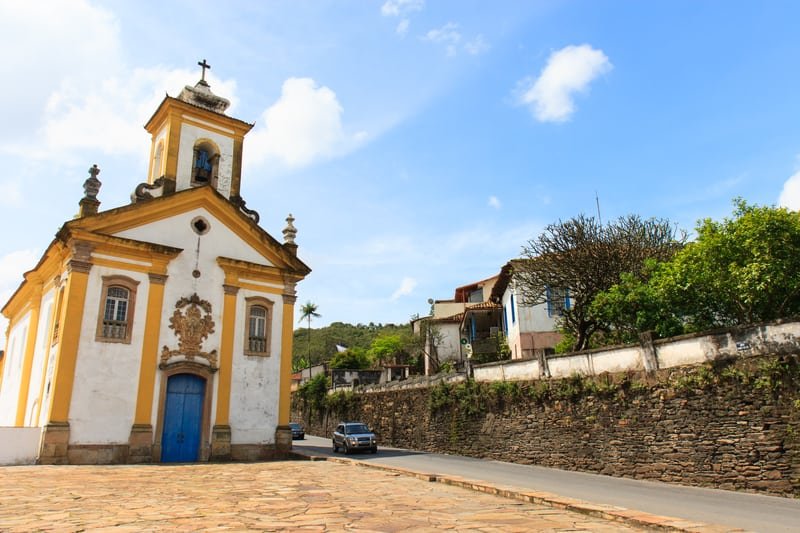
Therefore, the Baroque art movement in Brazil is very associated with Catholicism, with the Church playing an important role as a patron in colonial art. Since the Church financed the arts and religion was part of everyday life, most of the Baroque legacy is due to the Church.
The full development of the Baroque in Brazil occurred in the 18th century, after its emergence in Europe. The Baroque period extended until the first two decades of the 19th century, when its influence started to die down, and other art styles would become more popular.
Baroque has also influenced and manifested in Brazilian literature, music, and theater. These magnificent buildings are still found in some Brazilian cities to this very day, especially in Ouro Preto (Minas Gerais).
In addition, there are still massive churches in Bahia whose construction was influenced by Baroque art, like the São Francisco Church and Monastery (Igreja e Convento de São Francisco).
The peak of integration between architecture, sculpture, carving, and painting was manifested in Minas Gerais through the works of names such as Mestre Ataíde, and Aleijadinho.
Aleijadinho
Aleijadinho is considered the most important Brazilian plastic artist of the Baroque from Minas Gerais. The sculptures and churches he designed and decorated can still be found in the historic cities of Ouro Preto, São João del Rei, Congonhas (known as Congonhas do Campo at that time), Sabará, and other close towns.
One of his most renowned works of architecture is the exquisite facade of the São Francisco de Assis Church, located in Ouro Preto. However, Aleijadinho was not just an extraordinary church architect and decorator; he was also an incomparable sculptor whose work was known for their penetrating eyes, characterized by their expressiveness and drama.
In the Sanctuary of Bom Jesus de Matosinhos, in Congonhas do Campo, you can still marvel at his sculptures depicting the 12 biblical prophets carved in soapstone: Isaiah, Jeremiah, Baruc, Ezekiel, Daniel, Hosea, Jonah, Joel, Abdias, Habakuk, Amos and Nahum – as well as 66 wooden images that constitute a way of the cross.

Each of the prophets was sculpted in natural size, in a different position, using coordinated gestures. In this sense, Aleijadinho managed to do something extraordinary, as the sculptures suggest to the observer that the stone figures are moving. The elaboration of these sculptures took about five years, as the artist wanted his work to render gestures that had expressive balance and harmony.
Mestre Ataíde
Mestre Ataíde is another big name when it comes to Brazilian Baroque (or Barroco Mineiro more particularly) at the beginning of the 19th century. His art comprehends the carving and gilding of religious images, as well as paintings on panels and church ceilings.
He had a notable preference for vivid colors (especially blue), and his depictions of the saints, angels, and virgins sometimes had mixed-race features, which would later on make him be recognized as one of the pioneers of true Brazilian art identity.
The artworks of Mestre Ataíde are widely spread across the cities of Minas Gerais. His first works date back to 1781 when he carved and gilded several Jesus Christ statues made by Aleijadinho. Both were great collaborators in several projects, such as the Bom Jesus de Matosinhos Sanctuary in Congonhas do Campo.
Both artists would also colaborate in the making of the Igreja da Ordem Terceira de São Francisco de Assis, in Ouro Preto. Mestre Ataíde painted six panels that mimicked tile mosaics and also decorated the main chappel’s walls. His work “Assunção da Nossa Senhora” depicts Mary with mixed-race features.
In 1806, Mestre Ataíde painted the ceiling of the Matriz de Santo Antonio’s church (located in Santa Bárbara) main chappel, where the artworks known as The Ascension of Christ (“Ascensão de Cristo”) and The Crowing of Virgin Mary by the Holy Trinity (“A coroação da Virgem pela Santíssima Trindade”) are the highlights.
Accompanied by painters such as João Batista de Figueiredo and Antônio Martins da Silveira, Mestre Ataíde founded the Mariana School of Arts (Escola de Mariana) in 1821, receiving the title of professor in the arts of architecture and painting, influencing several upcoming artists.
Brazilian Neoclassic Art
At the beginning of the 19th century, when french general Napoleon Bonaparte’s armies invaded Portugal, the king of Portugal, D. João VI, saw himself forced to flee with his family and court to Brazil. The arrival of the Portuguese royal family would be another major landmark that changed the history of art in the country.
The Portuguese Court was established in Rio de Janeiro, which, during the 19th century, was the capital, both political and cultural, of the Portuguese empire. King D. João ruled Brazil until 1822, when the country became independent. At that time, Brazil was the only monarchy in the Americas.
During his reign, D. João VI created several administrative bodies in Brazil, such as the School of Medicine, a banking institution called Banco do Brasil (which still exists today), as well as the Royal Library, the Royal Press, and the Royal Theater of São João.
He also created the Royal Academy of Fine Arts, which was the first Brazilian institution dedicated to teaching art.
In 1816, a group of French artists came to Brazil, which became known as the Missão Artística Francesa (French Artistic Commission). The comission included, among other artists, Jean-Baptiste Debret, Nicolas-Antoine Taunay, Félix-Émile Taunay, Auguste Taunay and Le Breton.
Then King D. João VI hired the French Artistic Commission to institute the official teaching of the Arts in Brazil. These artists sought to portray the daily life of the Portuguese colony in Brazil in a romantic way by idealizing the figure of the indigenous natives and natural landscapes and highlighting a sense of nationalism by painting portraits of the royal family.
Jean-Baptiste Debret (1768-1848), who was referred to as “the soul of the French Commission,” mainly depicted the Brazilian way of life in his work. The artist, who carries titles such as draftsman, watercolorist, scenographic painter, decorator, and painting teacher, organized the first Art exhibition in Brazil in 1829.
The arrival of the French Artistic Commission in Brazil started the Neoclassicism trend in the country, a movement that defends the return to classic ideals. With Neoclassicism, a sense of simplicity resurfaced, which was one of the main characteristics of the movement, in opposition to the exaggerations of the Baroque.

Neoclassicism was originally based on the revival of the classic, that is, on the artistic styles of ancient Greece and Rome. With the emergence of Neoclassicism, the population began to imitate European culture even more, and the artistic movement began to be taught academically at the Royal Academy of Fine Arts.
Brazilian Romantic Art (Romantic Era)
Romanticism was an art movement born in Europe (more precisely in Italy, Germany, and England) at the end of the 18th century. It was popularized in Brazil by the hands of Gonçalves de Magalhães, a Brazilian writer born in Rio de Janeiro.
In 1836, Gonçalves de Magalhães released a book called “Suspiros Poéticos e Saudades”, which would later be understood as a landmark in Brazilian Romanticism. In this piece, the author focused on themes such as patriotism, nationalism, individualism, and the idealization of nature and childhood, all of that wrapped in a feeling of nostalgia.
And that’s where Brazilian Romanticism has its roots based on, as the country was fresh from its independence from Portugal. So there was a burning need to pull away from the Portuguese origins and forge a new reality.
At the same time, Brazil was going through several political, economic, and social changes, as a mix of uncertainty and a strong will to build a new country resonated in the general population. Nationalism grew stronger by the day, and the ideals of freedom consolidated amongst the artists and intellectuals as well.
In the plastic arts field, Nationalism also transitioned to the artist’s canvas, which portrayed and immortalized key scenes of Brazilian national history. The main goal was to help in the creation process of a new national identity for Brazil, something that was still in its early stages of development.
The Brazilian Romantic paintings that you see in this post represent the artistic ideals of that period in the country, which aimed at establishing a strong, brave, and heroic Brazilian identity. For that reason, the paintings had a softness to them but still depicting the country as a solid unit with a courageous history.

Some historians attribute this national appreciation to the close look of Dom Pedro II, who reigned in the country from 1931 to 1889, and was the last monarch in Brazil. With a strong sense of duty and devotion to its country and people, Dom Pedro II was adamant in building a solid social and cultural Brazilian unity, picturing the image of a civil and advanced country.
In sum, Brazilian nationalism found a way to grow throughout the country through the lenses of the Romantic movement, which recreated a visual representation of important historical moments. Aside from that, themes like nature and the rehabilitation of the native indigenous people were also common, aiming to make peace with a turbulent past.
Brazilian Naturalist Art
In the final years of Dom Pedro II’s reign (and final moments of the Brazilian Monarchy), a new artistic movement was starting to rise in the country, led by a book released in 1881 called “O Mulato” by Brazilian author Aluísio de Azevedo.
Aside from the political changes, the country was also going through major changes, as the Second Industrial Revolution was going strong and Capitalism was exponentially growing around the world. As a result, the need for human resources intensified, which meant more machines and more people working.
In 1888, Princess Isabel signed the Brazilian Golden Law (Lei Áurea), setting the slaves free and helping to set the country in a different direction. After that, the Brazilian society became more vocal and aspired to freedom and to break away from the past.
The Naturalist authors, influenced by all these significant events, tried to portray the reality with less flourishing and more authenticity. They had an objective view, with the themes being approached without sugarcoating anything. They also were firm believers that Science was the solution for all the issues humankind had.
Naturalist artists are considered anti-Romantic, as their style was the complete opposite of the latter. They aimed to tear down what the Romantic era build by telling the facts how they were and speak on the injustices and disorder that the Brazilian people were going through.
The main focus shifted to the lower classes, depicting their everyday life through realistic images set on nature-related scenarios. This art direction started in Europe, mainly in France, with artists such as Jules Bastien-Lepage (1848-1884) as one of the propelling forces of this movement.
Brazilian Expressionist Art
The Expressionist movement was a trend that presented a strong Avant-guard direction to the Arts, reverencing the subjectivity and the emotional value of the themes. Expressionism originated at the end of the 19th century and the beginning of the 20th century, arriving in Brazil in the early 1900s.
Prominent in visual arts, architecture, movies, literature, photography, and dancing, Expressionism as an art movement has an exceptional legacy, composed of singular pieces that aimed to question and dissociate beauty from art.
Aside from that, it highlighted the importance of art pieces with a deeper meaning, breaking away from previous trends that portrayed nature in an obvious and shallow manner. In this sense, Expressionism in Brazil and worldwide proposed a new way of making art, based on the appreciation of emotions and personal and intuitive compositions.
The main features that distinguished the Expressionism movement are:
- an appreciation of the artist’s perspective while elaborating its pieces
- having pain and suffering as a recurrent theme
- disengaging in need to portray reality in a faithful manner
- an appreciation of the human emotion
- the usage of disconnected brushstrokes in the visual arts
- the presence of contrasting colors and themes charged with criticism
The Expressionist Era in Brazil had big names as the main examples of artists that were able to capture the primal features of that trend, especially in regards to subjectivism and the social and political criticism that was so present at that time.
As the main examples of artists from that era, we can highlight the following:
Anita Malfatti
Anita Malfatti was a Brazilian painter that was key to the history of modern art in the country. Born in the state of São Paulo in 1889, she fell in love with visual art in 1912, when at the age of 23, she started to study painting and art trends.
She then embarked on several trips across the globe when she had her first encounter with the Expressionist movement in Germany. Soon after that, she learned and developed the techniques used by the artists she met in the country.
Fast forward to 1914, Anita returned to Brazil and had her first art showing. Propelled by the cultural and artistic skills she managed to flourish during her trips, she quickly detached herself amongst other Expressionist artists in the country, becoming one of the biggest names of the genre in Brazil.
Lasar Segall
Although Lasar Segall wasn’t actually born in Brazil (he is originally from Lithuania), he was a key figure in the history of Brazilian art. Born in 1889 and having already established himself as a dedicated artist by his 30s, Lasar moved to Brazil at the age of 34, where his art peaked.
Composing pieces that mainly exploited war and pain as his main inspirations, his artwork legacy showcases a lot of influence from the Expressionist trend. In this sense, he became crucial in spreading this art movement throughout Brazil.
Amongst his vast collection, a piece titled “Morro Vermelho” (Red Hill) is one of the most significant Brazilian Expressionist works of art, and also one of Lasar’s most famous paintings.
Candido Portinari
Born in 1903 in Rio de Janeiro, Candido Portinari is probably the most famous Brazilian artist outside the country. Alongside Malfatti and Segall, Portinari established himself as one of the main representatives of the Expressionist art style in the country.
His works are filled with social criticism, with pieces that showcase a lot of inner reflection and pain. By using striking colors and a unique style that made him be quickly recognized, Candido Portinari’s work was vital to the expansion of Expressionism in Brazil.
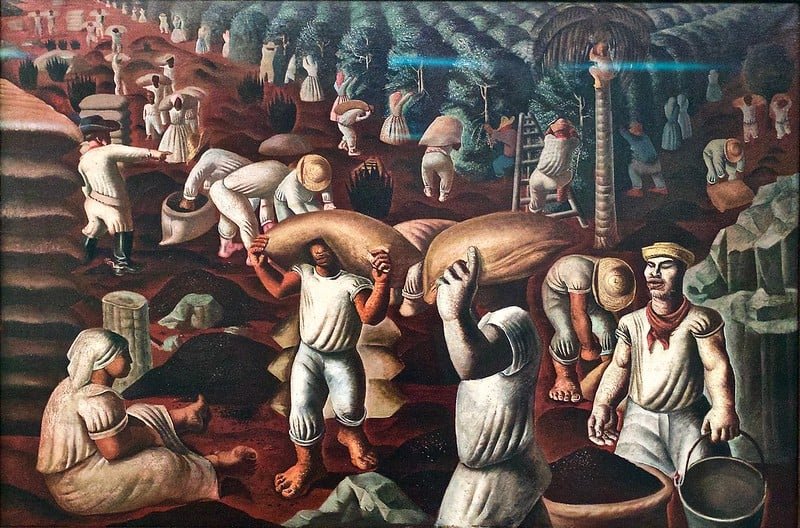
The piece “Retirantes,” made in 1944, is one of his most significant pieces, showcasing the best that Brazilian Expressionism had to offer.
Brazilian Modernist Art
The term Modernism is used to designate the artistic manifestations that, following the rapid changes in the late 19th and early 20th centuries, tried to translate the new reality and the new ambitions that were imposed on the “modern human” and society.
In Brazil, there was a clear attempt to get the country back on its feet in the political field but also in regards to the arts, as there was this newfound motivation to break free from the traditionalism of past art directions. That ended up leading to one of the most important events in the country’s art history.
There was an overall feeling of dissatisfaction amongst Brazilian citizens, as in their point of view, the national economic, political, and cultural spheres were completely static. Part of that was because money and power were solely focused on the hands of the great farmers in the states of São Paulo and Minas Gerais.
The two states alternated in the country’s presidency from 1889 to 1930, leaving the rest of the states displeased with the lack of opportunities and representation. At that time, these two states were the most influential in the country, and that exchange between the two lasted up until 1930 when a “coup d’etat” deposed then-president Washington Luís and put an end to the old politics.
It’s important to understand the turmoil that was going on in the country to really get why the artists at the time felt so eager to revolutionize the current aesthetics and showcase a new point of view. They aimed for something that was freer and less traditional and rigid.
Semana de Arte Moderna – Modern Art Week (1922)
Then, in 1922, there was an event called “Semana da Arte Moderna” (Modern Art Week) held in São Paulo. The art show was led by a group of artists called “Group of The 5”, consisting of artists Anita Malfatti, Mário de Andrade, Menotti del Picchia, Oswald de Andrade and Tarsila do Amaral.
The event counted on several presentations and showings and had a major role in the emergence of new magazines, manifestos, artistic movements, and groups of artists that had a fresh eye and an innovative point of view to aesthetic experimentation.
In the theater lobby, open all week, there was an exhibition of fine arts by works by Anita Malfatti, Di Cavalcanti, Victor Brecheret and other artists. In Literature, there was the participation of Mário de Andrade, Oswald de Andrade, Ronald de Carvalho, Graça Aranha, Guilherme de Almeida, Menotti Del Picchia and Paulo Prado. In Music, Heitor Villa Lobos and Guiomar Novaes participated.
This true artistic revolution presented the following proposals:
- anti-academics, anti-traditionalism and anti-pasadism
- desecration of the work of art
- humor, iconoclasm, irreverence
- freedom of creation and expression
- formal experimentalism
- approximation between written and spoken language: incorporation of colloquialism
- absolute predominance of the free verse
- absorption of European vanguards – of ISMOS
Several of these artists received support, including financial support, from members of the Partido Republicano Paulista, from the newspaper Correio Paulistano and from members of the new bourgeoisie from São Paulo and Rio de Janeiro, such as Armando Álvares Penteado, Paulo Prado, and Alfredo Pujol.
The organizers of the Modern Art Week launched a modernist manifesto. They defended freedom of speech and the adoption of “the most modern forms of expression from outside the country”. The goal was not to copy them but to recreate them and make them their own.
This Brazilian artistic expression would contain different elements – characteristic of the different Brazilian regions, environments, and eras – both rural and urban, both ancient and modern. After Modern Art Week, several artists started to develop their own painting style, which started to be more valued in Brazil.
Tarsila do Amaral
Tarsila do Amaral (1886 – 1973) was a Brazilian painter and artist whose “Abaporu” painting (painted in 1928) is her most famous piece. Alongside writers Oswald de Andrade and Raul Bopp, Tarsila do Amaral launched the “Anthropophagic” movement in Brazil, which is considered the most extreme in the Modernist Era.
During the early ages of the Modernist movement, Tarsila do Amaral was one of the most prominent plastic artists, as she managed to capture all of the Modernist aspirations and ideas in her work. Her work can be divided into 3 distintic phases:
Phase 1 – The Pau-Brasil Era
Tarsila’s Pau-Brasil Phase began in 1924 when writer Oswald de Andrade published the “Pau Brasil Manifesto,” which was essentially the aesthetic notion that would guide his future poetry and work. This made Tarsila do Amaral break away from conservatism.
She started filling her work with colors and shapes inspired by her trip to Minas Gerais, accompanied by her Modernist peers. She started to explore tropical thematics, the Brazilian fauna and flora, as well as symbols of the urban modern age, such as railroads and machinery.
Phase 2 – The Anthropophagic Era
Tarsila’s second artistic era originated from the Anthropophagic movement, led by artists who claimed that all foreign cultures should be devoured and their essence expressed through the art, although not losing any Brazilian cultural identity along the process.
The movement was inspired by Tarsila do Amaral’s painting “Abaporu” (1928), which in the native indigenous Tupi language, means “cannibal”. The painting was given to writer Oswald de Andrade as a birthday gift from Tarsila.
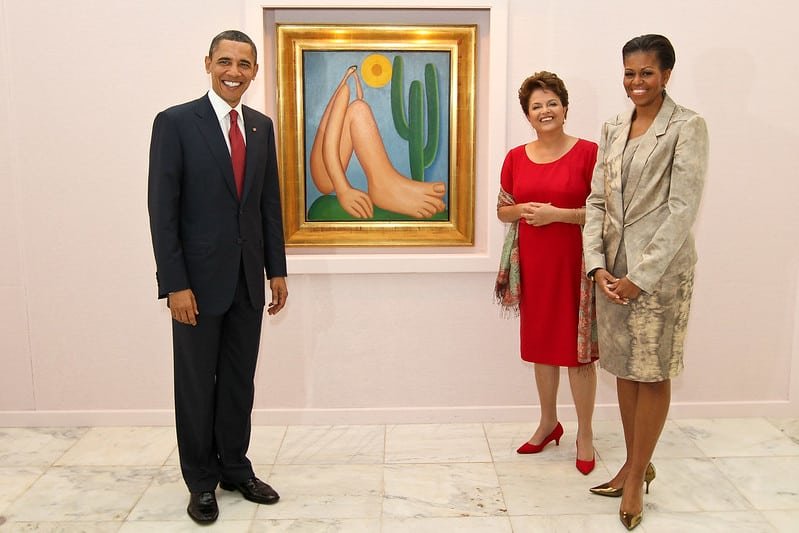
Phase 3 – The Social Era
Tarsila’s third and last phase began in 1933 with a painting called “Operários.” This era heavily focused on the social issues of the time, as well as on the workers and everything regarding Brazilian labor and workforce.
This last era was inspired by Tarsila’s trip to the Soviet Union in 1931, which led the artist to tackle more substantial issues when she returned to Brazil.
Victor Brecheret
Victor Brecheret. although born in Italy, was an important character while introducing modern art to the Brazilian sculpting scene. The artist studied at the Liceu de Artes e Ofício art school when he was only 18, and on his 19th birthday, he went back to Rome to enhance his techniques.
During the Modern Art Week, the sculptor wasn’t physically present due to the fact he was living in Paris at the time but still managed to send 20 sculptures to the event, encouraged by friends Di Cavalcanti, Mário de Andrade, and Oswald de Andrade. He went on to become one of the most prominent figures of the event.
Di Cavalcanti
Di Cavalcanti’s importance in the history of Brazilian art is huge to say the least. The artist was a big fan of depicting typical Brazilian themes in his artwork, such as samba, carnaval, the favelas, and the women.
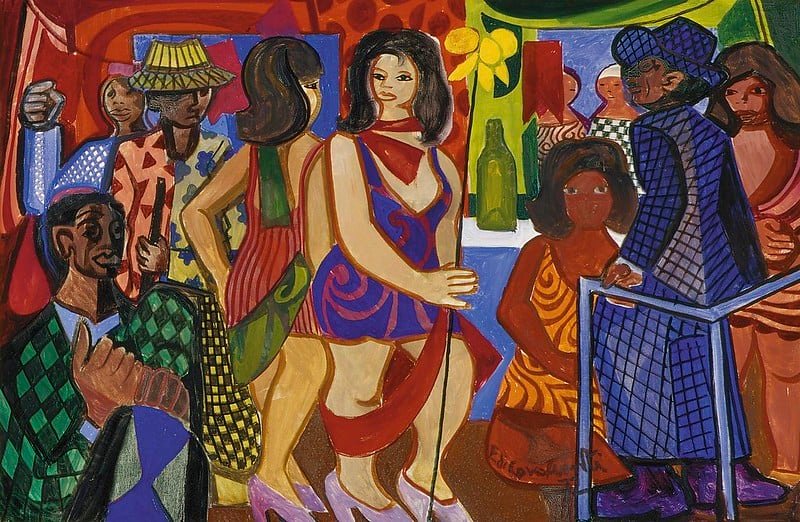
Before becoming huge during the Modern Art Week in 1922, Di Cavalcanti worked with several Brazilian writers such as Manuel Bandeira, Vinicius de Moraes, and Jorge Amado, creating covers for some of their work. He was also responsible for the Modern Art Week’s catalog cover, as well as showcasing 11 of his paintings during the event.
After affiliating himself with the Brazilian Communist Party, he was persecuted by the government and moved to Europe, where he continued to showcase his paintings.
Current/Contemporary Brazilian Art
In 1951, an event called Bienal was founded in São Paulo. In the 1960s and 1970s, Brazilian art began to be exhibited internationally, hitchhiking on the Bossa Nova’s newfound success. At the same time, technology was advancing like crazy, making artists from all over the world resourcing to computers in order to create their pieces.
In the 1980s, Brazil was going through a social and political crisis, which prompted artists to express their nonconformity through their art. The pieces became more and more provocative, opinionated and political, questioning every artistic norm and rule so far.
The artists in general slowly stopped following international trends and started creating their own artistic identity, gaining notoriety and respect throughout the museums around the country.
Here are a few Brazilian contemporary artists:
Gonçalo Ivo
Gonçalo Ivo’s work is primarily known for its imperfect geometric elements and the fact that the artist uses color in an intuitive manner. His body of work is very consistent in using both of these elements, making him a fairly easy Brazilian contemporary artist to recognize.
His “Composição VI” piece is very representative of Gonçalo’s style, which you can see here (as well as other paintings by him).
Saint Clair Cemin
Saint Clair Cernim is a Brazilian sculptor who began his career experimenting with Surrealist art. But Saint Clair would only gain notoriety when he started using different types of material (such as bronze, ceramics, marble, and stainless steel) in his sculptures, which prompted him to national and international fame.
His “And Then (I Shut My Eyes)” sculpture is a perfect representation of his work. Built in a mix of bronze and lacquered carbon fiber, this piece aims to reference a meditating figure, which the artist likes to refer to as “an imperfect Buda”.
Ernesto Neto
Constantly referenced as one of the most notable Brazilian installment artists in current times, Ernesto Neto’s work is truly amazing. Using all kinds of material and using all sorts of inspiration for his work, Ernesto Neto has gained a LOT of international attention, having had his work exhibited in important galleries such as the Tate Gallery (in London) and the Guggenheim in New York.
One of the key aspects of Ernesto’s work is the ability to engage the observers to participate and interact with his art installments, not only making them part of the artwork but also as part of the artistic intervention planned by him.
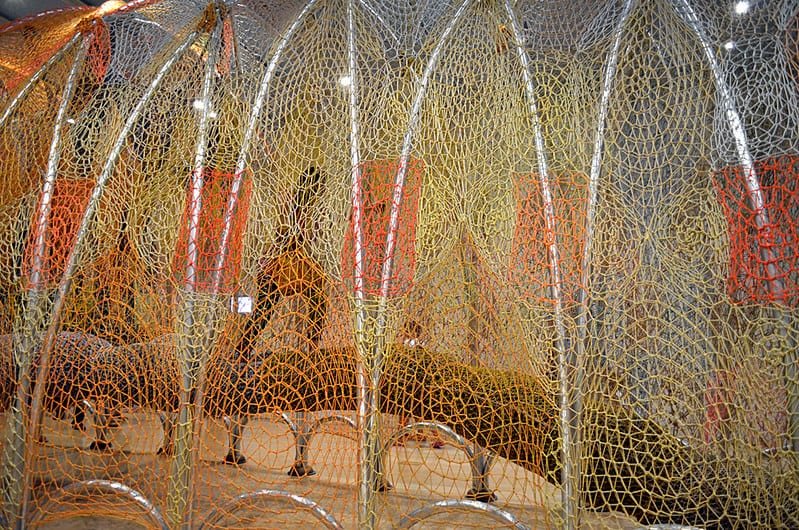
His “Cuddle on the Tightrope” installment was completely done in crochet (inspired by his grandmother) and represents a uterus, which the observers and explore like they are in a maze.
Cildo Meireles
Cildo Meireles is a concept and installment artist as well as an engraver, who had a key role in Brazilian art in the 1960s. He was one of the first artists to openly critique de military dictatorship regime through his pieces, something that was perceived as bold and courageous at the time.
His body of work is very diverse, which you’ll find, from huge installations and mazes to fake banknotes and Coca-Cola bottles with subversive messages on their labels. Cildo Meireles wanted to get a full reaction from the observers, making people interact and engage with his pieces.
Well, we have finally reached the end of our post and I hope we gave you enough material for you to feel inspired! Brazilian art is constantly evolving, so if you happen to be in the country, don’t forget to include an art gallery or two on your schedule!
While you’re here, I think we might interest you with these:
Beyond Samba: 7 Brazilian Dances You Must Know – I’m sure you have seen (or maybe even experienced) Brazilian Samba, but have you tried the Carimbó yet? Click here to find out more about this and other amazing Brazilian dances!
Anitta: Who is The Brazilian Singer Taking Over The World? – if you haven’t heard about Brazilian singer Anitta by now, then you have got a lot of catching up to do! But don’t worry, we got everything you need to know about her right here!
Rio Carnival: Instruments Used And How It Is Organized – watching a Brazilian Carnaval parade may seem like a lot of fun, but there is also a lot of hard work involved while getting the show on the road! Come find out how it all works!
Cover Image: “Eternos caminhantes” by Lasar Segall (1919) – Credit: WikiCommons | Marcelo monzani netto
